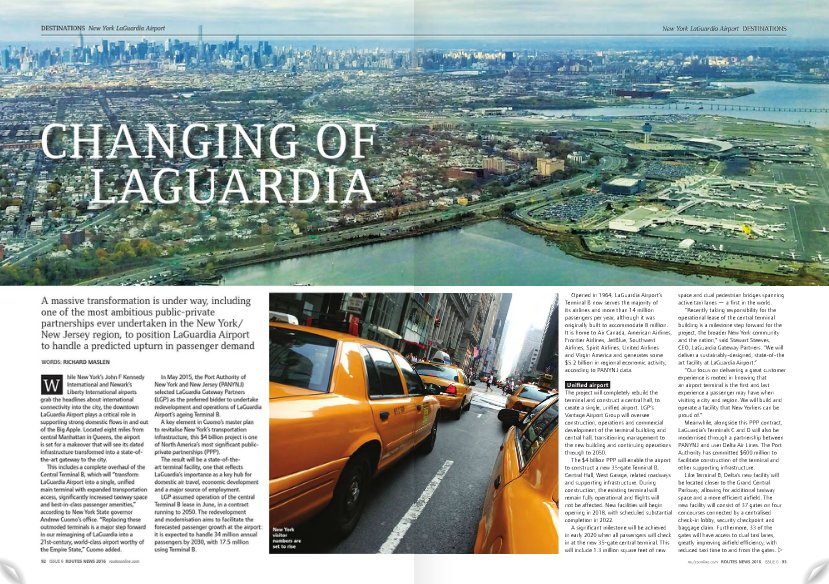While New York’s John F Kennedy International and Newark’s Liberty International airports grab the headlines about international connectivity into the city, the downtown LaGuardia Airport plays a critical role in supporting strong domestic flows in and out of the Big Apple. Located eight miles from central Manhattan in Queens, the airport is set for a makeover that will see its dated infrastructure transformed into a state-of-the-art gateway to the city.
This includes a complete overhaul of the Central Terminal B, which will “transform LaGuardia Airport into a single, unified main terminal with expanded transportation access, significantly increased taxiway space and best-in-class passenger amenities,” according to New York State governor Andrew Cuomo’s office. “Replacing these outmoded terminals is a major step forward in our reimagining of LaGuardia into a 21st-century, world-class airport worthy of the Empire State,” Cuomo added.
In May 2015, the Port Authority of New York and New Jersey (PANYNJ) selected LaGuardia Gateway Partners (LGP) as the preferred bidder to undertake redevelopment and operations of LaGuardia Airport’s ageing Terminal B. A key element in Cuomo’s master plan to revitalise New York’s transportation infrastructure, this $4 billion project is one of North America’s most significant publicprivate partnerships (PPP).
The result will be a state-of-theart terminal facility, one that reflects LaGuardia’s importance as a key hub for domestic air travel, economic development and a major source of employment. LGP assumed operation of the central Terminal B lease in June, in a contract running to 2050. The redevelopment and modernisation aims to facilitate the forecasted passenger growth at the airport: it is expected to handle 34 million annual passengers by 2030, with 17.5 million using Terminal B.
Opened in 1964, LaGuardia Airport’s Terminal B now serves the majority of its airlines and more than 14 million passengers per year, although it was originally built to accommodate 8 million. It is home to Air Canada, American Airlines, Frontier Airlines, JetBlue, Southwest Airlines, Spirit Airlines, United Airlines and Virgin America and generates some $5.2 billion in regional economic activity, according to PANYNJ data.
The project will completely rebuild the terminal and construct a central hall, to create a single, unified airport. LGP’s Vantage Airport Group will oversee construction, operations and commercial development of the terminal building and central hall, transitioning management to the new building and continuing operations through to 2050.
The $4 billion PPP will enable the airport to construct a new 35-gate Terminal B, Central Hall, West Garage, related roadways and supporting infrastructure. During construction, the existing terminal will remain fully operational and flights will not be affected. New facilities will begin opening in 2018, with scheduled substantial completion in 2022.
A significant milestone will be achieved in early 2020 when all passengers will check in at the new 35-gate central terminal. This will include 1.3 million square feet of new space and dual pedestrian bridges spanning active taxi lanes — a first in the world.
“Recently taking responsibility for the operational lease of the central terminal building is a milestone step forward for the project, the broader New York community and the nation,” said Stewart Steeves, CEO, LaGuardia Gateway Partners. “We will deliver a sustainably-designed, state-of-the art facility at LaGuardia Airport.”
“Our focus on delivering a great customer experience is rooted in knowing that an airport terminal is the first and last experience a passenger may have when visiting a city and region. We will build and operate a facility that New Yorkers can be proud of.”
Meanwhile, alongside this PPP contract, LaGuardia’s Terminals C and D will also be modernised through a partnership between PANYNJ and user Delta Air Lines. The Port Authority has committed $600 million to facilitate construction of the terminal and other supporting infrastructure.
Like Terminal B, Delta’s new facility will be located closer to the Grand Central Parkway, allowing for additional taxiway space and a more efficient airfield. The new facility will consist of 37 gates on four concourses connected by a centralised check-in lobby, security checkpoint and baggage claim. Furthermore, 33 of the gates will have access to dual taxi lanes, greatly improving airfield efficiency, with reduced taxi time to and from the gates.
LaGuardia leads for domestic arrivals
LaGuardia Airport is the largest domestic gateway into New York and despite its infrastructure constraints it will this year again provide more than 35 million scheduled seats in and out of the city. In fact it will offer its largest inventory for the past 10 years, according to published schedules for the full calendar year. Its largest operator is Delta Air Lines with a 42.2% capacity share, ahead of American Airlines (19.8%), Southwest Airlines (9.3%), US Airways (9.0%), United Airlines (8.2%) and JetBlue Airways (5.6%).
Newark's new slot solution
While LaGuardia Airport is developing for the future, Newark’s Liberty International Airport is delivering extra capacity now as additional slots have become available at the hub for United Airlines.
The US Federal Aviation Administration (FAA) has long had a cap on slots at Newark to limit congestion, but these were removed in April and airlines are now being awarded rights for the forthcoming winter 2016/17 schedules. This is the first time slot restrictions have been eased since 2008, when the FAA placed temporary limits on scheduled operations at Newark in May that year to mitigate congestion and delays. It was concerned about a spillover effect from the limited operations at JFK during the busy summer scheduling season.
However, the port authority is planning major runway reconstruction at JFK in 2017 and 2018, which will have an impact on overall runway capacity. With the timing of upcoming construction in mind, the FAA is continuing to analyse scheduled demand, operational performance and potential capacity changes at JFK.
The FAA is now designating Newark as a Level 2, schedule-facilitated airport under the International Air Transport Association Worldwide Slot Guidelines. This will allow more efficient use of the airport terminal and runway capacity. Newark is currently designated as a Level 3, slot-controlled airport, limited to 81 operations per hour.
“The significant improvements in on-time performance and delays at Newark allowed us to make these changes,” said FAA administrator Michael Huerta. “This change will improve access to some of the most in-demand airspace in the country and has the potential to provide more options for local consumers.”
In the past month some US carriers have begun to open reservations for new regular air services into Newark. Spirit Airlines will debut links from Fort Lauderdale, Myrtle Beach and Orlando from October; Alaska Airlines will add domestic daily links from Portland and San Diego in November and San Jose from March, as well as adding a third daily Seattle service from May 2017.
Elsewhere, Southwest Airlines will add a twice-daily link from Fort Lauderdale in March 2017, while Virgin America is introducing a fourth daily rotation on routes from Los Angeles and San Francisco. The new slots will reduce the dominance of United Airlines at Newark, although it will remain the largest operator. The carrier has been hit by a $412 million charge in the second quarter through the devaluation of its landing and take-off slot pool after the removal of the restrictions.
 |
This article is modified from an original feature that appeared in... ROUTES NEWS - ISSUE 6, 2016 PLEASE CLICK HERE to view the magazine. |
 |
